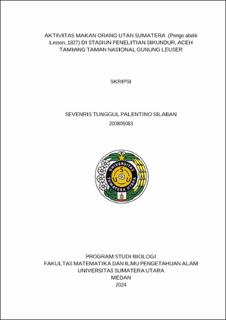| dc.description.abstract | Gunung Leuser National Park is the only habitat for Sumatran orangutans. The presence of Sumatran orangutans plays an important role in dispersing plant seeds. Seed dispersal can reduce competition and increase seed survival. This study aims to analyze the feeding activities, the seed dispersal patterns and to identify the type of food of Sumatran orangutans. There were 2 research objects, a juvenile female orangutan named Mala and an adult female orangutan named Suci. Data recording of feeding activity was conducted using the Focal Animal Sampling (FAS) method, while sample collection was conducted by using the Purposive Sampling method. The results showed that Mala's feeding activity was observed for 4090 minutes and 4550 minutes compare to other activities, while Suci's feeding activity was observed for 1322 minutes and 1558 minutes compare to other activities. Both orangutans ate more fruit than other types of food such as young leaves, cambium, leaf tubers, flowers, and insects. There were 3 times of seed dispersal by Sumatran orangutans through feces by the distances of 818 meters, 595 meters, and 408 meters respectively. In comparison, endozoochory seed dispersal also occurred 3 times by the distances of 81 meters, 68 meters, and 48 meters respectively. Orangutan defecation activity during the observation is recorded 22 times by scattering 44 plant seeds. All seeds dispersed are ≥ 3mm in size. The types of food plants eaten by Mala and Suci orangutans totally are 33 species come from 21 families observe. The most commonly consumed food species came from the Moraceae family, namely Artocarpus integer, Ficus fistulosa, Ficus drupaceae, Artocarpus elasticus, and Ficus sp. However, the dominants food of orangutans feeding during observation is pandanus fruit (pandanaceae). Further studies on seed fate analysis are needed to determine the growth capacity of orangutan dispersal seeds and to conduct research on seed dispersal with a larger sample population and compare with other dispersal agents in the community to gain a foundation knowledge to the conservation of orangutans and their habitats. | en_US |


